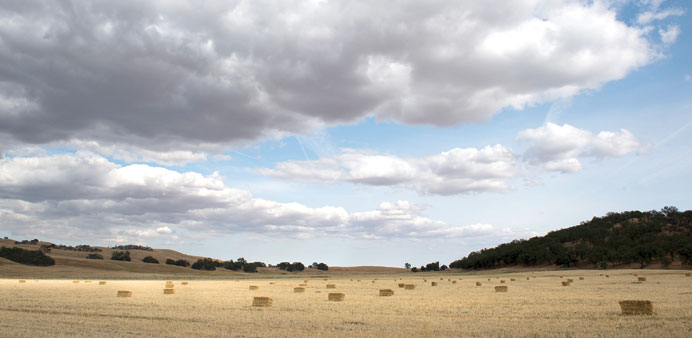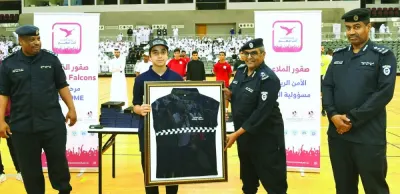By Sam McManis
The earth shook, or so it seemed. Dust billowed, cattle scattered. Horses thundered at full gallop, their reverberative hooves clawing in the shifting soil. A grown man went flying, rag doll-like, then gripped a wobbly steer’s horns for purchase. Cries and yells punctuated the scene. A guy’s bottle can got knocked clear out of his grasp, landing in a frothy puddle under a gnarled, arthritic oak tree.
It was all over in less than a minute.
Another temblor here in this speck of a Central California town dubbing itself “Earthquake Capital of the World”?
Nah, just the rodeo in town for a rollicking Memorial Day weekend, the raucous crowd responding to nothing less than controlled chaos during an arena event called Cowboy Doctoring, in which nine rope-wielding cowboys astride horses try to mark recalcitrant calves with the clock ticking. Quite the spectacle.
But thoughts naturally turn to movement, seismically speaking, in Parkfield, pop. 18, located at the very heart of the 810-mile-long San Andreas Fault. Surrounded by the Cholame Hills, 25 miles northeast of Paso Robles, this tawny and, currently, parched valley floor is famous — or maybe notorious — as the most geologically active stretch of the state’s most active fault.
About once every 22 years, this spot where the Pacific and North American plates meet and rub shoulders endures some serious shaking: 6.0-magnitude quakes, on average, the most recent in 2004. USGS seismologists have taken notice and set up field stations to monitor that movement, even drilling a bore hole to place sensitive equipment that notes every shift and sway, every iota of frisson that might help researchers better understand the ground beneath our feet.
Except for a beige US Geological Survey trailer as you hit town, nothing suggests the extent of study taking place. And, really, there’s nothing much to see of the actual fault itself. It runs along a mostly dry creek bed shaggy with riparian foliage, which obscures the slightly differing rocks on each bank. The iron bridge that crosses the creek — the only way into town — is only slightly bent, after highway road crews repaired it several years ago. A sign at one end states, “Now Entering North American Plate,” while on the other side, heading west, a sign states “Now Entering Pacific Plate.”
Really, though, there’s nothing dramatic here that screams “earthquake zone,” nothing to make you want to summon Dwayne (The Rock) Johnson and his rescue helicopter to swoop down and save you, as in the new film, San Andreas, not even any stark photos to be taken, like the exposed zipper farther south at Carrizo Plain National Monument.
Yet, Parkfield in California USA has turned what might be a liability — think about it, who would choose to hang out at a veritable earthquake Ground Zero? — into a cute marketing gambit.
This place with no stop signs — and, weekdays, more cattle than people — draws hundreds on weekends, especially during the summers and fall. They pass by a water tower proclaiming the “Earthquake Capital of the World,” eat the “Shakin’ Burger” and “Magnitude 6” steak at the Parkfield Cafe, hole up in the Parkfield Lodge, whose come-on is to “Sleep Here When It Happens.”
They aren’t coming for the unlikely event of an earthquake, and most visitors don’t bother to grab the handout detailing a “self-guided” fault walking tour.
No, they come because Jack Varian, 79-year-old cattle rancher and cowboy impresario, has lured them with “experiences.” He and wife Zera, and their brood of four children and nine grandchildren, run cattle drives for people participating in a dude-ranch weekend. He rents out a good chunk of his V6 Ranch (“20,000 Acres of Freedom” the slick brochure reads) to horsemanship workshops, family-oriented cowboy academies, the seemingly mixed-messaged “Richard Winters All Women’s Horsemanship Retreat,” Western artisan boutique fairs and two big attractions in May, the annual bluegrass festival and the Parkfield Rodeo.
On the recent rodeo weekend, Parkfield was an epicentre of cowboy culture. Hundreds spilled out of the cafe into the park and children’s play structure, including hard-bodied guys in tall hats. Pickup trucks and horses shared parking spaces. Free-range children and dogs scampered along the dusty roads, giddy at being unleashed. Down by the arena, commerce held sway with booths selling designer jeans from Booty House Couture, kettle corn and funnel cakes and smoothies and chai tea for the city slickers, the weight-loss supplement Plexus Worldwide, saddle pads, hay tubes and farriers insurance.
“Everybody always comes out for the rodeo, because it’s a great family weekend,” said Heather Martinez of Shandon, 25 miles south. “It’s awesome how they made a big deal out of the earthquake thing and turned it into an Old West town. You don’t expect something this big out here.”
Probably the only person who expected it was the man who envisioned it. Varian was raised to think big. His father, Sigurd, invented the klystron tube, which made radar possible, and developed one of the first high-tech companies in Silicon Valley. But Jack gravitated south, to the rolling hills of interior Monterey County, establishing himself as a cattle rancher. It was in the mid-1980s, with the combination of a drought and the return of his post-college-age children, that he got to thinking big. As in The Big One.
“I thought, here’s Parkfield, it’s got earthquakes, it’s got history,” Varian said. “Cholame is an Indian term and it means ‘The Pretty One.’ And the valley is so beautiful, I asked myself, ‘Would one percent of the 30 million people within four hours’ driving time be willing to come here?’”
“The problem was, (the town) was really just a dump. Right where we’re sitting (the cafe) was a house that had a big oak tree laying over it. Across the road (where the lodge now sits) were a couple of trailers only. City Hall was in disrepair. A lot of empty lots were for sale. I bought ‘em.”
A few years later, when oldest son John graduated from Cal Poly, San Luis Obispo and “decided Parkfield wasn’t the worst place to live,” according to Jack, father and son sought to prop up the ailing town. First came the cafe, then the lodge, both designed and built by John, a lodgepole furniture artisan. Then the earthquake branding idea (“What’s that old saying about lemons and lemonade?” Jack asked). Then Katie, Jack and Zera’s oldest, and a professional barrel racer, started the rodeo. Then inspiration came to Jack at a movie theatre in Paso Robles.
“That’s what really started it all — City Slickers,” said Varian, referring to the 1991 Billy Crystal movie. “I leaned over to my wife and said, ‘You know, we can do that.’”
Eventually, people started coming to him, asking him to put on events. The Parkfield Bluegrass Festival brings in more than 1,000 “pickers and pluckers” every Mother’s Day Weekend. A mountain bike race is held each summer in the hills above the ranch. The dude ranch draws, well, lots of dudes.
“We’ve been coming (to the rodeo) for 20 years,” said Skip Brown of Sherman Oaks, “and we probably wouldn’t have known about this great place without it.”
Most locals support Varian’s efforts. Many, after all, are employed by him. But several long-time residents, including Joe and Jacquita Jensen, say their peaceful valley has been overrun.
“Too many people come here, far as I’m concerned,” Jacquita said, whose business is Parkfield Quakey Shakey Eggs. “I don’t like the rodeo. I don’t like the bluegrass. I don’t like the weddings, parties, what not. It goes on all summer long. We have to put up with the riff-raff and loud noise.”
Varian isn’t exactly quaking in his boots over the criticism.
“In order for this family to stay in business, the first thing you gotta do is pay the bills,” he said. “If this rodeo helps pay the bills, then I really can’t worry too much about a person who’s inconvenienced once in a while.”
Same could be said for the tectonic relationship between Parkfieldians and their environment. An occasional seismic shudder may be an inconvenience, but they’ve learned to roll with it. —The Sacramento Bee/TNS

FIELD WITH A FAULT LINE: The San Andreas fault runs across this field in Parkfield.


